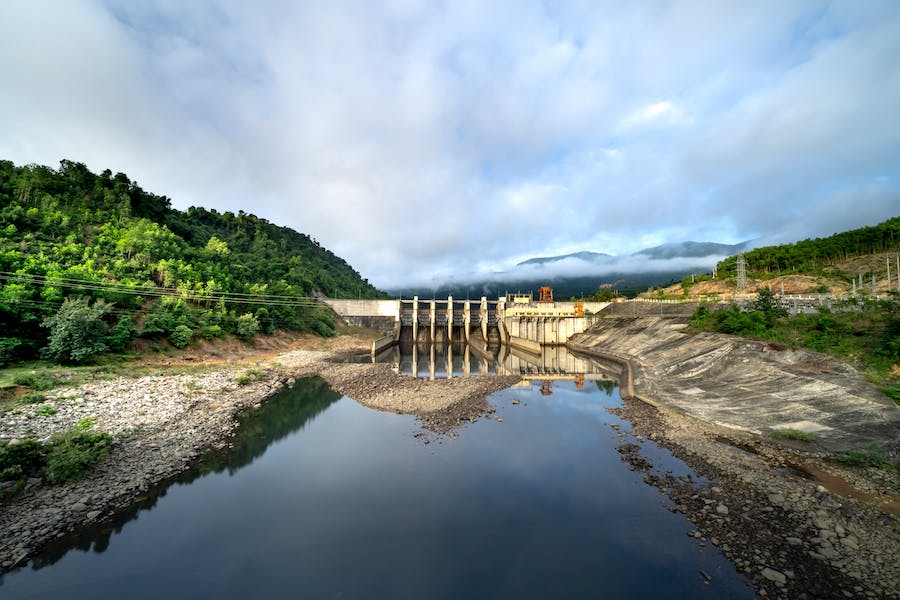Water sustains life, drives economies, and shapes landscapes. But how do we ensure that it’s managed effectively and sustainably for the benefit of people and the environment? This is where the concept of integrated water resource management (IWRM) offers solutions to complex water-related problems.
At Cypress, we integrate this holistic approach to manage the sustainable use of water resources. IWRM isn’t just a buzzword; it’s a comprehensive strategy that includes various engineering, scientific, and planning facets of water management.
In this article, we explore the fundamentals of IWRM, understand its significance in addressing water-related challenges, and how it aligns with our mission at Cypress.

What Is Integrated Water Resource Management?
Integrated water resource management (IWRM) is a comprehensive approach to managing and governing water resources. At its core, IWRM aims to promote the sustainable and equitable use of water for various purposes, considering the interconnections between water, ecosystems, and human development.
The holistic approach to water management
IWRM helps us at Cypress adopt an integrated approach that considers the complexities of water resources. It recognizes that water issues go beyond merely supply and demand. Holistic water management considers the following aspects:
- Hydrological cycle – A crucial part of IWRM requires understanding the natural processes of water circulation, from precipitation to runoff, infiltration, and evaporation.
- Ecosystem health – Protecting and restoring ecosystems like wetlands and rivers is integral to IWRM, as they play a vital role in maintaining water quality and supporting biodiversity.
- Social and economic factors – IWRM acknowledges the social and economic dimensions of water management, including access to water, peoples’ livelihoods, and economic development.
- Legal and policy frameworks – Effective IWRM requires clear legal and policy frameworks that guide decision-making and proper resource allocation.
Key Principles of IWRM
The key principles of IWRM serve as building blocks and guide the decision-making processes aimed at achieving sustainable, equitable, and integrated water resource management.
Sustainability
IWRM places a strong emphasis on the sustainable use of water resources. It involves managing water in a way that ensures its availability for present and future generations. This principle recognizes the finite nature of water and the importance of using it wisely without depleting or degrading the resource.
At Cypress, environmental, economic, and social considerations are all part of achieving sustainability in water management.
Equity
Equity entails ensuring that water resources are fairly and justly distributed among various users and stakeholders. Examples of potential stakeholders include communities, agriculture, industry, and ecosystems.
We at Cypress understand that achieving equity is not only about dividing water resources equitably, but also considering the needs of marginalized or vulnerable groups who may have limited access to clean and safe water.
Social inclusivity
IWRM recognizes that water management decisions have significant social impacts. Therefore, with IWRM, we seek to include all members of society, regardless of their gender, age, or economic status.
Inclusivity ensures that water management solutions are designed to benefit the entire community and that no one is disproportionately affected.
Participation
Meaningful participation of stakeholders is vital for effective water management. This principle entails engaging various actors, including local communities, in decision-making processes.
Engaged stakeholders can provide valuable insights into local water issues, help identify priorities, and contribute positively to the development of sustainable water management strategies.
Integrated planning
Traditional water management often operates in isolated sectors, such as water supply, agriculture, and sanitation. IWRM breaks down these silos and encourages planners and decision-makers to take a comprehensive view of water resources.
Integrated planning involves considering all aspects of water distribution, including supply, quality, and sanitation, in a coordinated manner.
Integrated management
Integrated management recognizes that different sectors, such as agriculture, energy, and industry, rely on water resources. IWRM encourages the harmonization of these sectors to optimize water use while minimizing waste and pollution.
It also considers the ecological aspect, ensuring that water management practices are in line with the protection and restoration of natural ecosystems.

The Role of Environmental Engineers in IWRM
Environmental engineering and IWRM
At Cypress, our environmental engineers play a pivotal role in implementing IWRM principles and practices. Their expertise is critical in addressing the multifaceted challenges of water resource management.
- Water treatment and quality control – Our environmental engineers are responsible for designing and operating water treatment facilities in order to ensure that water is safe for consumption and complies with quality standards. They employ various treatment methods to remove impurities, pathogens, and contaminants from water sources.
- Ecosystem restoration – Our engineers contribute to the restoration of ecosystems that are vital for water quality and biodiversity. They design and execute projects with the goal of rehabilitating wetlands, rivers, and other natural systems.
- Wastewater management – Effective management of wastewater is essential for protecting water quality and the environment. Environmental engineers at Cypress are heavily involved in the design and operation of wastewater treatment plants, ensuring that pollutants are removed before discharge.
- Sustainable infrastructure – Environmental engineers design sustainable infrastructure for water supply, distribution, and sanitation. They aim to maximize efficiency, minimize water loss, and reduce energy consumption in water-related processes.
Skills and expertise needed
Environmental engineers working in the IWRM field require specific skills and expertise:
- Hydrology and water resources management – A strong foundation in hydrology (the science of water) and water resources management is essential. Our environmental engineers must understand the movement, distribution, and quality of water in natural and built environments.
- Environmental regulations – Knowledge of environmental regulations and compliance is crucial for ensuring that water management projects adhere to legal and ethical standards.
- Data analysis – The ability to collect, analyze, and interpret data related to water quality and quantity is fundamental. Environmental engineers rely on data to make informed decisions.
- Stakeholder engagement – Effective communication and collaboration with various stakeholders, including local communities and government agencies, are vital for successful IWRM projects.
- Sustainability awareness – Environmental engineers need to integrate sustainability principles into their work, which involves considering the long-term impact of water management decisions on the environment, society, and the economy.
As stewards of water resources, our engineers are central to the implementation of IWRM, since they contribute their technical knowledge and skills to address water challenges in an integrated and sustainable manner.
Components of IWRM
Integrated water resource management is comprised of several key components, each of which play a critical role in the sustainable management of water resources:
Governance and policy
- Water governance – Effective governance is the cornerstone of IWRM. This requires the establishment of legal frameworks, policies, and regulations that govern water use, distribution, and protection.
- Stakeholder engagement – Policies must promote the active involvement of all stakeholders, including local communities, government agencies, industries, and environmental organizations.
- Conflict resolution – Addressing conflicts over water use is a component of key governance. IWRM policies should include mechanisms for resolving disputes and ensuring equitable resource allocation.
Planning and allocation
- Resource assessment – A comprehensive assessment of available water resources, including surface and groundwater, is essential. This involves evaluating quantity, quality, and seasonal variations.
- Water allocation – The efficient allocation of water resources and considering competing demands and environmental needs, is a central aspect of IWRM. This may involve setting priorities and quotas.
- Integrated land use planning – IWRM often integrates land use and water resource planning. Balancing urban development, agriculture, and environmental preservation is critical in pursuing our goals.
Infrastructure and management
- Water infrastructure – Developing and maintaining infrastructures for water storage, treatment, and distribution is a vital component. These include dams, reservoirs, pipelines, and wastewater treatment facilities.
- Efficiency and conservation – Implementing water-efficient technologies and practices is key to IWRM. This includes reducing water losses during distribution and promoting responsible water use.
- Ecosystem management – Preserving and restoring ecosystems that provide water-related services is part of infrastructure and management. Wetlands, forests, and riparian zones play a crucial role in water resource sustainability.
Monitoring and data
- Data collection – At Cypress, we believe that continuous data collection is essential for informed decision-making. This includes monitoring water quality, quantity, and usage patterns.
- Early warning systems – Developing early warning systems for extreme weather events, droughts, and floods is crucial to preventing natural disaster damage. Timely alerts help mitigate potential disasters.
- Adaptive management – IWRM relies on adaptive management, while data-driven decisions lead to adjustments in strategies and policies over time. This ensures resilience in confronting the changing conditions.
IWRM and Climate Change
Strengthening water resource management in a changing climate
Integrated water resource management takes on renewed significance in the context of climate change. Its core principles are adaptability and fostering resilience to meet shifting weather patterns and extreme events.
Gradual climate change results in increased unpredictability in precipitation, rising temperatures, and a higher frequency of droughts and floods. In response to this issue, IWRM prioritizes the development of climate-resilient infrastructure, robust contingency planning, and adaptive strategies.
In addressing these climate-related challenges, IWRM promotes resource efficiency, safeguarding water supplies during droughts, and advocates for responsible water usage in both agriculture and urban areas. The collaborative nature of IWRM and its adaptability makes it a powerful tool for managing the uncertainties caused by climate change.

Conclusion
Through this article, we have explored the value of integrated water resource management. By taking a macro view of the water cycle and coordinating across various sectors, this approach coordinates the needs of people and nature.
Understanding this issue through an integrated framework optimizes water supply reliability, quality protection, and ecosystem health. We hope this overview has provided insight into how holistic planning and adaptive policies enable the sustainable use of our limited water resources.
While the intricacies may seem complex, understanding what integrated water resource management is helps us create resilience in the face of growing demands.
As water becomes more precious, this comprehensive approach will only gain importance for securing water for both human and environmental needs far into the future.
